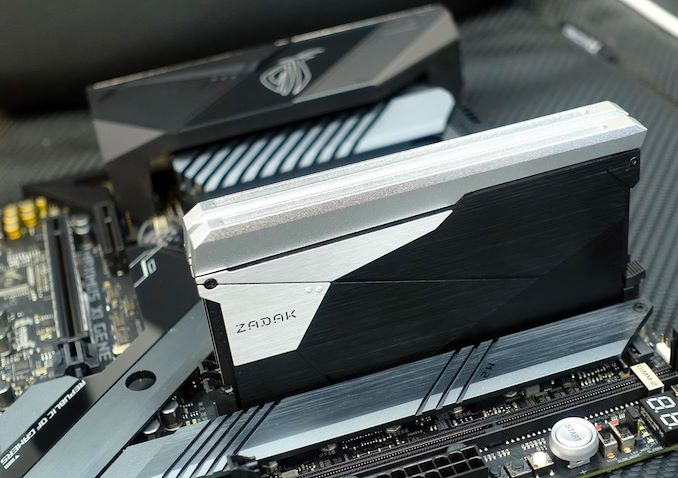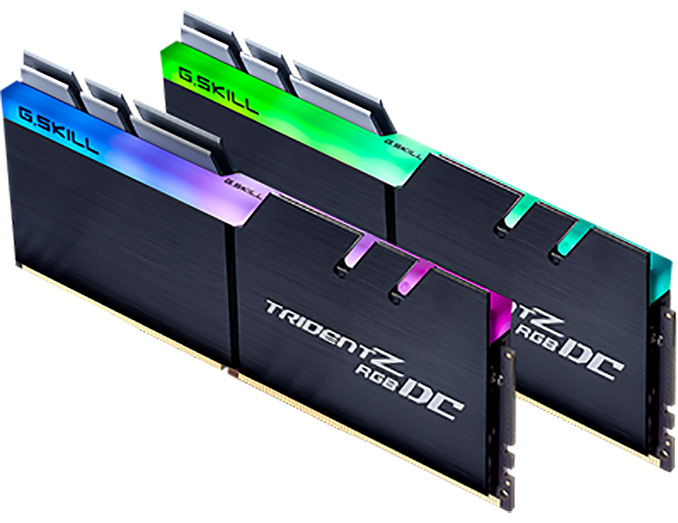Intel to Support 128GB of DDR4 on Core 9th Gen Desktop Processors
by Ian Cutress on October 15, 2018 9:00 AM EST
One of today’s announcements threw up an interesting footnote worthy of further investigation. With its latest products, HP announced that their mainstream desktop platforms would be shipped with up to 32GB of memory, which was further expandable up to 128GB. Intel has confirmed to us, based on new memory entering the market, that there will be an adjustment to the memory support of the latest processors.
State of Play
Normally mainstream processors only support 64GB, by virtue of two memory channels, two DIMMs per memory channel (2DPC), and the maximum size of a standard consumer UDIMM being 16GB of DDR4, meaning 4x16GB = 64GB. However the launch of two different technologies, both double height double capacity 32GB DDR4 modules from Zadak and G.Skill, as well as new 16Gb DDR4 chips coming from Samsung, means that technically in a consumer system with four memory slots, up to 128GB might be possible.
With AMD, the company has previously stated that its memory controller can support future memory that comes to market (with qualification), however Intel has been steadfast in limiting its memory support on its chips specifically within the specification. HP is now pre-empting the change it its latest launch with the following footnote:
This has forced Intel into a statement, which reads as the following:
The new 9th Gen Intel Core processors memory controller is capable of supporting DDR4 16Gb die density DIMMs which will allow the processors to support a total system memory capacity of up to 128GB when populating both motherboard memory channels with 2 DIMMs per Channel (2DPC) using these DIMMs. As DDR4 16Gb die density DIMMs have only recently become available, we are now validating them, targeting an update in a few months’ time.
At present Intel is only talking about the new Core 9th Gen processors that are set to hit the market on October 19th, which are the Core i9-9900K, the Core i7-9700K, and the Core i5-9600K. There has been no statement on previous generations of processors that support DDR4, or if there is any change on the high-end desktop platform for 256GB support.
Pricing for the newest 32GB memory modules is not expected to be cheap. A current 4x16GB kit comes in at around $550 for DDR4-2666, which is a ‘maximum supported’ memory kit, so a 4x32GB kit could easily run double plus a bit extra, perhaps in the $1200-$1600 range. That would put a single memory module at $300-$400, essentially costing more than most DDR4-capable processors.
Pricing aside, the main reason for the memory modules is likely not for changing peak memory capacity, but for enabling 2x32GB configurations, for prosumers that need 64GB in a small volume system. This is perhaps why Samsung’s first DDR4 32GB modules were SO-DIMM modules, to enable mobile workstations.
We will be monitoring the situation if more processors will be supporting these modules. G.Skill is sending us a sample and Zadak has stated we should be on the list, as ASUS ROG will be the first motherboard vendor to support both. Once we get a motherboard in to test we will see how well they perform.














24 Comments
View All Comments
rocky12345 - Monday, October 15, 2018 - link
I used to be one of those that always thought hey why do we need so much memory and after having 32GB's memory in my system for about 5 years and never using more than maybe 16GB's in the most demanding games and with other tasks running I finally found a way to use some of the extra memory. I setup PrimoCache with LVL1 & LVL 2 setup. LVL1 is set so it uses 8GB of my system memory and LVL2 is setup to use 68GB of my SSD drive. With both of these caches setup to cache 2 4TB standard hard disks that have games installed on them.It works very well and really speeds up the games I play as their loading times go down to a few seconds instead of the normal long wait times if you load them without the cache. This is with only a 32GB setup I can only dream what could happen if I had 64 or 128GB memory installed. It might not be the most graceful way to use up some of the extra memory in my system but I was happy to be able to find a way to at least make use of some of it that would normally just sit there doing nothing.
Tokamata - Monday, October 15, 2018 - link
And yet developers will continue to optimize memory usage at the expense of CPU usage.GreenReaper - Thursday, October 18, 2018 - link
In fairness, the first often directly correlates to the second, at least if it's memory the CPU has to operate on. Sure, you might have RAM to play with, but it's still gotta get into the cache in order to be operated on, or travel over the bus to your GPU. And it might have to push useful stuff out to do that.Often the best use of additional memory is for caching disk (where again, using as much of an abundant resource as you can is often a bad idea, compared to figuring out how to use less in the first place).
Xajel - Tuesday, October 16, 2018 - link
"However the launch of two different technologies, both double height double capacity 32GB DDR4 modules from Zadak and G.Skill, as well as new 16Gb DDR4 chips coming from Samsung, means that technically in a consumer system with four memory slots, up to 128GB might be possible."I know these both technologies are available, ASUS stated when they promoted the DC DIMM that these are intended for mITX motherboards with only 2 DIMM's to allow these mITX to support 64GB of RAM by using non-standard 32GB per DIMM.
But the new Samsung 16Gb DRAM chips will allow 32GB per DIMM without the need for DC DIMM.
In theory, if ASUS also supported those DC DIMM's on their mATX and ATX motherboards with 4 DIMM slots then they can support 128GB if the IMC can support it.
But also, the same thing can be achieved by using the new 16Gb DRAM chips could allow the same thing.
But, what if we used both, I mean DC DIMM with 16Gb chips ? this will allow the mITX to have 128GB and if the IMC support it a 2DPC in mATX/ATX to have 256GB.. again only if the platform support it. Which I doubt.
Sounds ridicules with current RAM prices and the actual mainstream needs, I mean currently any body needs more than 64GB will already be working on HEDT which already support that, so next gen. HEDT will support 256GB now ? cool.